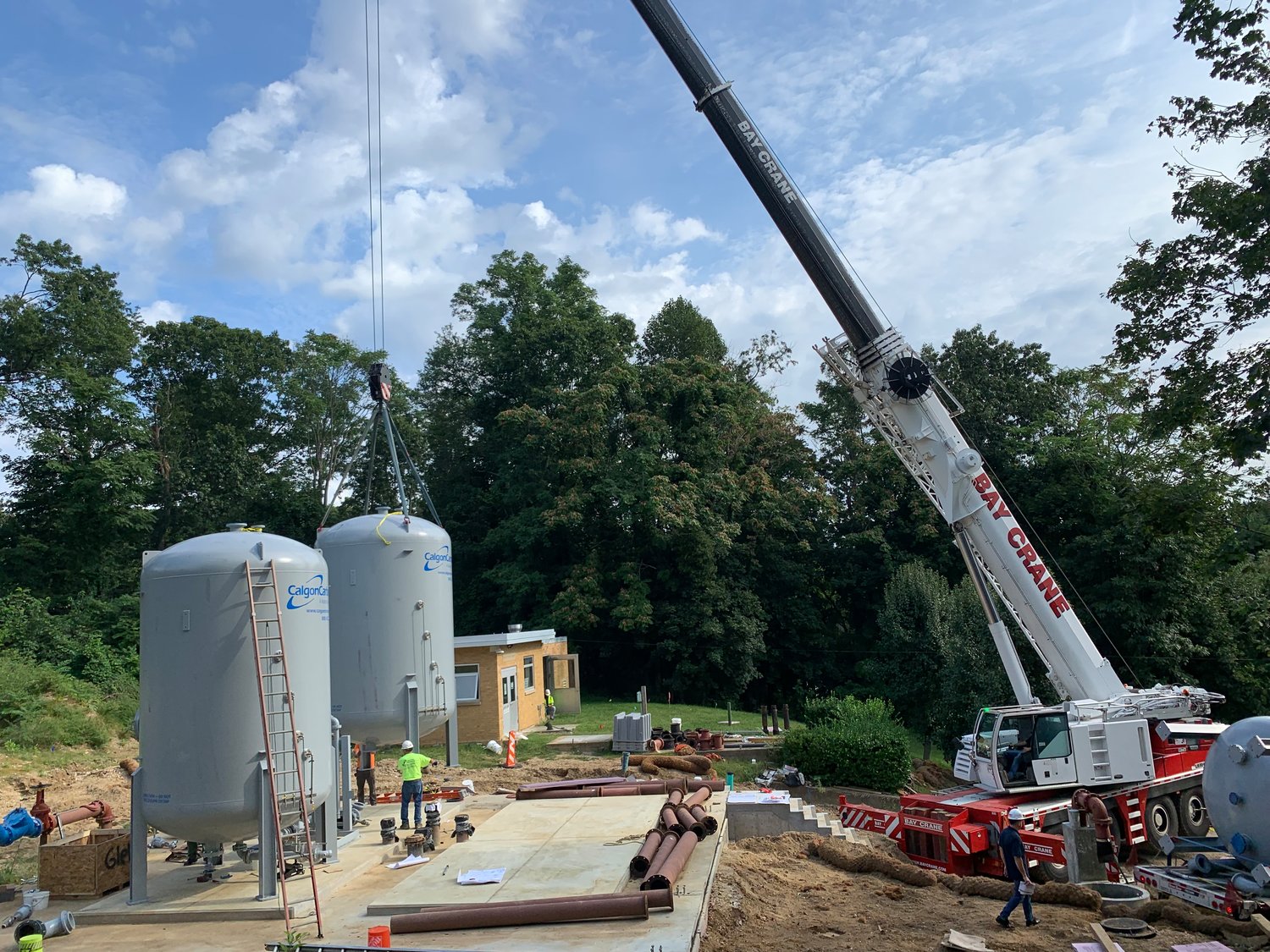NYAW updates Glen Head water treatment facility
Cleaner water expected at G.H. well site
New York American Water lifted two massive granular-activated carbon vessels into place at the updated treatment facility under construction at the Glen Head well site on Sept. 16. The carbon treatment system is being installed to address emerging contaminants PFOA and PFOS.
The treatment system contains granular-activated carbon filters, and when the water is pumped, it will run through the filters, absorbing the perfluorooctanoic acid (PFOA) and perfluorooctane sulfonic acid (PFOS) contaminants in the water before it is sent into the distribution system. The Glen Head site will house four large tanks filled with about 20,000 pounds of carbon in each tank.
“We just got the tanks delivered to the site, and the guys are out there doing all the piping connections now,” John Kilpatrick, manager of engineering at NYAW, said. “The other project to get finished at the site is a building around the tanks so there’s no freeze risks during the winter and the site will fit in more aesthetically in the community.”
In 2017, then Gov. Andrew Cuomo founded the New York State Drinking Water Quality Council to study dioxane, PFOA and PFOS compounds in the water. In 2018, the council recommended that the MCL, or the minimum contaminant level, which dictates the maximum level of contaminants allowed to be present in the drinking water supply, to be set at 10 parts per trillion, which is the lowest MCL of any state.
“These were very aggressive regulations that were put [in place],” what the levels of those contaminants should be, Kilpatrick said. “Prior to those regulations, the [federal Environmental Protection Agency] had guidance on PFOA [levels] in the water, at 50 parts per trillion. The EPA looked at what the health risk was to the most sensitive populations for a lifetime of exposure to water at 50 parts per trillion, and they said that was an acceptable risk. So the fact that New York is now mandating 10 parts per trillion is wild.”
When the state health department first tested the contaminant levels in the NYAW coverage areas in 2016, they were so minute they were not detected by the tests. Now, with improvements in water-testing technology, even the smallest amount of contaminant is detected.
“I think it’s important to note [how minute] these levels are and just how impressively far not only water treatment technology has come, but the advances in water testing as well,” said Greg Gordon, director of public relations at ZE Creative Communications, which is representing NYAW. “Just to put into perspective, a part per trillion is the equivalent to one second in about 32,000 years, so it’s impressive that the technology is able to remove a contaminant at such a minute concentration from the water.”
When the New York State Health Department began enforcing the new NCL levels in 2019, NYAW had several wells throughout its service territory that were now above those new aggressive levels. The Glen Head station’s levels of contaminants at the time of testing were about 17 parts per trillion. Because the level of contaminants was now over the state mandated limit, NYAW was required to put treatment on the well. Since the regulations were rolled out so quickly, NYAW officials said there was not much time to install the proper treatment. A deferral approved by the state health department gave NYAW an extra two years to build treatment facilities for all the wells that were above the minimum contaminant level.
When the deferral was approved in January, NYAW had already been designing and going through the permitting for the Glen Head facility.
“We started construction in the spring of this year; we’re hoping to have most of the construction done by the end of the year and be fully operational in the first quarter of next year,” Kilpatrick said.
Even with the current contaminant level for the Glen Head facility sitting at 17 parts per trillion, the water continues to be safe to drink, according to the state health department. The EPA’s federally mandated contaminant level remains at 50 parts per trillion for the most sensitive populations, including the elderly and nursing mothers, among others.
“The water providers’ role is to ensure that the requirements set by the health regulators are met,” Gordon said. “So providers aren’t the ones setting these regulations or doing any of these analyses on their own; it’s all coming from the team of experts at the varying levels of health departments that regulate them.”

 44.0°,
Mostly Cloudy
44.0°,
Mostly Cloudy 




